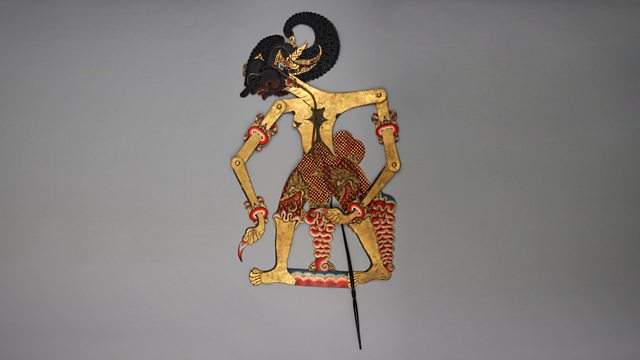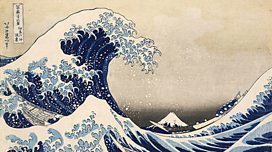Shadow Puppet of Bima
Neil MacGregor is this week looking at religion around 400 years ago. Today, he explores the the religious history of Indonesia - through a shadow puppet.
The history of humanity - as told through one hundred objects from the British Museum in London - is in South East Asia. This week Neil MacGregor, the museum's director, is with the objects from across the world around 400 years ago that explore the relationships between religion and society. Today he is with a shadow puppet from the Indonesian island of Java, asking how a puppet watched by a predominantly Muslim audience is a character from a Hindi epic. He describes the history of the theatre of shadows and explores how it reveals the religious traditions that have shaped Indonesian life. He talks to a puppet master from Java. And the Malaysian novelist Tash Aw discusses the influence of shadow theatre on the region today.
Producer: Anthony Denselow
Last on
![]()
Discover more programmes from A History of the World in 100 Objects about art.
About this object
Location: Java, Indonesia
Culture: Hindu World
Period: 1600 - 1800
Material: Animal Material
听
This shadow puppet is at least 200 years old and is one of the oldest surviving shadow puppets in the world. It represents Bima the hero of the great Hindu epic The Mahabharata. Puppets like this are still used in the shadow theatres of Java. Plays are performed through the night by a single puppeteer. The central theme of a shadow theatre is the battle between good and evil and it was believed that during the performance the audience were protected from all evil things.
Why was a Hindu epic performed by Muslims in Java?
Islam spread to South East Asia in the 1500s through maritime trade routes, and often through the conversion of Buddhist and Hindu rulers. Islam adapted, rather than suppressed, elements of Hinduism, Buddhism and ancient Indonesian traditions like the shadow theatre. In Java, for example, it is believed that the faces of shadow puppets were distorted to avoid the Islamic laws forbidding the creation of images of humans and gods. In contrast the shadow puppets of the Island of Bali, which remained Hindu, retain realistic human features.
Did you know?
- In 2003 the Wayang Kulit shadow theatre, Java was designated a 'Masterpiece of Oral and Intangible Heritage of Humanity'.
More than mere entertainment
By Anouska Komlosy, former curator, British Museum
听
There are a number of reasons why this Javanese shadow puppet is special: its fine workmanship, the way it brings to life the powerful and complex character of Bima, and its fascinating provenance as part of the famous collection made by Thomas Raffles when he was Lieutenant Governor of Java.
Puppets cannot be understood as art objects or ornaments, although they are exquisitely made. They are tools or instruments; part of a technology that enables communication and interaction with the worlds of spirits. Performance in Bali and Java was and remains so much more than mere entertainment.
The dalang or shadow puppet master is perhaps best understood as being akin to a shaman. He brings alive and gives voice to spirits and gods through the recitation of ancient legends and cosmic tales. The screen on which the shadows dance is like the veil between the spirit and everyday world, the dalang can aid and influence the forces which cross it. As such shadow theatre was and remains a powerful part of Indonesian ritual life.
Rulers of Java long recognised its cultural and political importance which is why Islamic rulers continued to patronise the art form which has both Hindu and pre-Hindu roots. Moreover political messages both dominant and subversive have been played out in the shadow theatre since Indonesian independence.
This puppet represents Bima, a physically powerful and yet ambiguous character capable of both great stupidity and great compassion. Bima is one of the five Panawa brothers whose war with their cousins the Kaurava forms the heart of the Hindu epic of the Mahabharata. He is generally good but has characteristics which make him terrifying. These can be clearly seen in this this puppet - he has round eyes and a twirling and full moustache both evidence of his strength and ability to induce fear.
The puppet has a powerful wide-legged stance and Bima鈥檚 distinguishing long thumb nails, used to slaughter foes and tear through obstacles. His status as one of the courtly Pandawa brothers is shown in his headdress and jewellery and his relationship to the gods may be reflected in the Garuda heads which adorn his leg cloths. These cloths have a characteristic black and white pattern and were a gift from his wife, the ogress Dimbi.
The dilemmas which Bima faces teach that strength alone is not enough for success in life, mindfulness and compassion are also essential.
Telling the story
By Sumarsam, Indonesian puppet master
听
The learning鈥檚 in the past are mostly by observation and imitation, but in the twentieth century there is - the people can actually learn in the schools of puppetry, so in that case written documents are also part of the learning process.
Technically the puppet master will have to of course tell the story but also to make the puppet to move, sometimes in remarkable ways and he is also accentuating the movements of the puppets with the sound of metal plates [which] hang in the puppet鈥檚 box which he kicks with his foot and in making the puppet to move the puppeteer hold the main stake in between his thumb and his index finger, the other finger hold or move 2 stakes each is attached the arm of the puppets.
You need to control the puppet themselves sometimes 2, 3, 4, up to 6 puppets sometimes at one time. The puppet master will have to know when to give a signal to the musicians when to play. And of course the puppet master also keep voices of puppets in dialogues between 1, 2 or 3 puppets and sometimes the puppet master also sings a mood songs to set up the atmosphere of a particular scene. The puppet master will have to use his arms and legs, all of this have to be done while the puppet master sitting down cross legged.
I think I would say that it is kind of fun to do it but also a fairly challenging task.
A subversive method of social commentary
By Tash Aw, writer
听
Another interesting thing about the shadow theatre is that although it has obviously became less important in the big cities where the influence of cable TV and the internet like everywhere else in the world have become much more widespread, in the cultural heartland of not just Indonesia but places like Malaysia it鈥檚 still very, very important. But ironically these are the places where Islam is at its purist and therefore most fundamental. So when you consider the fact that shadow puppets veer dangerously close to idolatry it鈥檚 a very interesting mix of how something so seemingly un-Muslim sits in a community that is very, very Muslim. Because of course people in those places don鈥檛 have access to the internet in the way they might do in Jakarta or Kuala Lumpur.
Indonesian politics is and always has been extremely turbulent and I think this is reflected in the response in the shadow theatre, the way it鈥檚 reinvented itself. Whereas traditionally it was seen as something that gave entertainment, but also moral and spiritual guidance, nowadays it鈥檚 seen much more as a sort of slightly underground or subversive method of social commentary, simply because it so difficult for the government to censor it and it has such close contact with even people in very small villages who might not be able to understand say a political film quite so easy but who would be very able to grasp the subtleties of a shadow play.
Before the advent of TV and before the spread of TV in Indonesia in the 1960s, the shadow theatre was probably the primary form of educational messages. It was the way the government disseminated things that they wanted to get across to people and it was also probably the main form of entertainment. And whereas you would have thought that nowadays with a TV in practically every household certainly in the cities it would be rendered superfluous, in fact it hasn鈥檛 and it鈥檚 lasted the course and is still a very, very important part of Indonesian cultural life.
Transcript
Broadcasts
- Wed 29 Sep 2010 09:45麻豆官网首页入口 Radio 4 FM
- Wed 29 Sep 2010 19:45麻豆官网首页入口 Radio 4
- Thu 30 Sep 2010 00:30麻豆官网首页入口 Radio 4
- Wed 8 Sep 2021 13:45麻豆官网首页入口 Radio 4
Featured in...
![]()
Art—A History of the World in 100 Objects
A History of the World in 100 Objects - objects related to Art.
Podcast
-
![]()
A History of the World in 100 Objects
Director of the British Museum, Neil MacGregor, retells humanity's history through objects





